

The French five-key flute is elegantly simple, yet capable of executing early and mid-19th century romantic flute music with agility and subtlety, and a beautiful sound. Its lightness and mechanical simplicity contribute to its agility.

Some of this agility, and certainly some simplicity, may be lost when further keys are added, but by 1820 or 1830, the eight-key French flute was not uncommon and additional keys like the e'''/d''' trill key, may be found on some French flutes. See the flutes by Tabard and Buffet below (described more fully here), though the Buffet is from a later period.
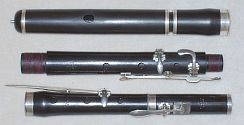
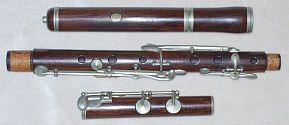
The virtuoso flutist and composer Jean-Louis Tulou (1786–1865) was Professor of Flute at the Paris Conservatoire from 1829 to 1856. He had begun manufacturing flutes in 1828. A partnership with flute maker Jacques Nonon began in 1831, and ended in 1853. Tulou supplied instruments to the Paris Conservatoire from 1831 to 1859. While it is said that he preferred a four-key flute for his own use, Tulou was responsible for several "improvements" in the flute's mechanism.
One early innovation was a special F# key intended to sharpen the note produced by the ordinary F# fingering [123 4-- k]. This note tends to be quite flat on French flutes (in order to preserve the forked fingering [123 4-6] for F natural in the first two octaves, and to help the fingering [12- 4-- k] for the third octave F) and the player had to pay special attention lest it sound flat. The Tulou F# key is a key mounted sideways on the lower center joint, crossing the short F key, which controlled a small hole between the 4th and 5th finger holes. When F# is fingered as [123 4--] and this key is pressed with RH4 or possibly RH3, the F# becomes significantly higher. This may be used when the F# was to be played piano, especially in adagios, or as a leading tone.

Tulou was an ardant opponent of the Boehm flute, whose sound he criticized. When a course on the (conical) Boehm flute at the Conservatoire was proposed by Victor Coche in 1839, Tulou expressed strong objections and announced (early 1840) that he was working on an improved flute himself. (The course was not aproved, and the Boehm flute was not adopted by the Paris Conservatoire until 1860, after Tulou retired and Dorus had become Professor of Flute.)
This improved flute is the "flûte perfectionée" described and illustrated in a c.1842 edition of Tulou's Methodé de Flûte. The following illustration is from a Paris edition of 1851.

Tulou has made use of rods and needle springs. He has switched to a three-part construction with all six finger holes on one center joint; this is necessary for the new trill keys he has introduced.
In addition to the usual keys of the eight-key flute, we see the Tulou F# key, a second C key with a touch between the second and third finger holes, for LH3, and two trill keys controlling holes above finger hole 1 that Tulou calls the "C# key" and the "D trill key". In addition, there is a "fragment" of a key that may be seen below finger hole 1; this is a mystery. It may be that the fragment is supposed to be attached to an axle and work in in conjunction with some other key touch. (Tulou's flute is often referred to as having 12 keys, and there are already 12 touches without this fragment.)
Tulou's C key for LH3 is a variation on the small horizontal C key in back of the flute, operated by the base of LH3, that appears on earlier English and German flutes and was in occasional use for the entire 19C. Tulou's C key may be seen below on a flute by Couesnon (Paris, early 20C).
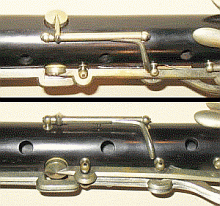
The trill keys are controlled by levers between the third and fourth finger holes (C# key), and the fourth and fifth finger holes (D trill key). A lever for a C key is parallel to the C# key lever but closer to hole 4. With finger hole 1 closed, the C lever produces the notes c'' and c''', and the C# level gives a c'''#, but not a good c''#. The D# trill key is the common key for the e'''/d''' trill and a few other high trills. Tulou gives the chart below for the improved trills (click on the image for a larger version). The C and C# levers are often to be used together, but this is easy as they are purposely placed close together and both can be pressed simultaneously with RH1.
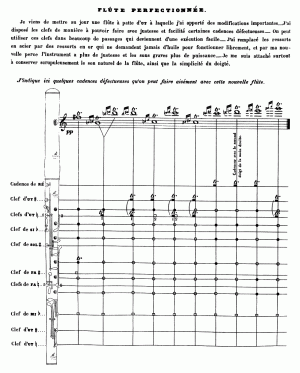
The chart shows that the C key for LH3 is used for two of the trills, including a nice d''/c'' trill. Otherwise, I find little use for this key.
Here is a flûte perfectionée made by Nonon, Tulou's one-time partner.

This flute has a B foot (uncommon on French flutes), and so 13 keys. More extensive use is made of rods and needle springs. For example, on this flute the Tulou F# key is mounted on a sleeve (with the key cup visible between finger holes 4 and 5 and its touch just visible near the low D# key). Nonon has removed the C key for LH3 and provided an additional C key for the left hand thumb.
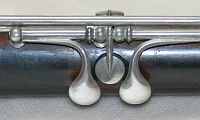
I am informed by Angel Juan Benito, a Spanish flute collector, that the Tulou flûte perfectionée was the Madrid Conservatory official flute for many years until Francisco González Maestre introduced the wooden Boehm there, around 1888.
The Tulou flute, in spite of its relatively intricate mechanism, remains a simple system flute. The six finger holes are unemcumbered by ring keys or key cups and all keys on the body are closed-standing. In fact, because of its relatively small holes, the keys may be ignored and it can be played, after a fashion, as a one-key flute.
The Paris firm of Couesnon & Cie., which was in business from 1882 to post 1950, offered flutes after Tulou's designs. A catalog circa 1900 (see Tula Gianini's Great Flute Makers of France, p.212) offers "Flutes Tulou" with 5, 6, 9, 10, and 12 keys, The prices of the 5 to 10 key flutes range from 45 to 80 fr. But the 12-key flute costs 240 fr., more than their least expensive Boehm flutes, and was presumably a flûte perfectionée of some sort. A Couesnon catalog from 1930–31 no longer lists Flutes Tulou, though "flutes système ordinaire" with 5, 6, 8, and 10 keys were still offered.
We remark that the Couesnon flute whose second C key was featured above has an interesting brille mechanism for the right hand.

This mechanism cures the flat F# problem automatically (see the paragraph below) and makes the Tulou F# key unnecessary. (Cf. the F#-mechanism of Schwedler and Kruspe.)
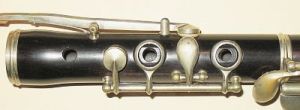
The ring keys and a small key covering a hole between finger holes 4 and 5 are on the same sleeve and held away from the body by a spring. Thus the supplementary hole remains open and acts as a vent for notes fingered by the left hand and the first finger of the right hand. In particular, it sharpens the F#'s, without the need to press any side key. The supplementary hole is closed when either hole 5 or 6 is closed, and, for example, the forked fingering [123 4-6] for F natural is available and in tune. This is greatly convenient in the first two octaves, but causes some changes in the third octave. For example, the fingering [12- 4-- k] for f''' is lost.
The Rampone (Milan) catalog of circa 1923 offers a number of "flauti sistema Tulòu". The first two models with 12 and 13 keys are presumably similar to Tulou's orginal flûte perfectionée. But their other models have two or four ring keys.

We see Tulou's trill keys and his C key for LH3 (but no Tulou F# key). The ring keys have nothing to do with Tulou and are probably related to ideas of P. Pupeschi.
Reference: Great Flute Makers of France, Tula Gianini
(Tony Bingham, London, 1993).
